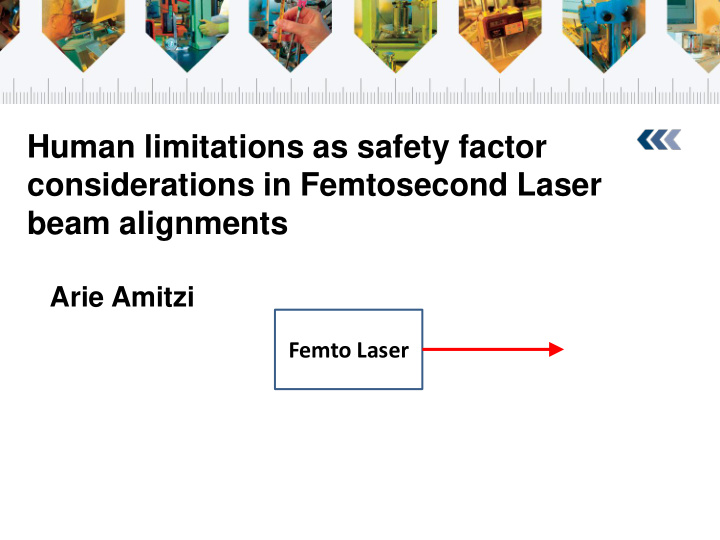



Human limitations as safety factor considerations in Femtosecond Laser beam alignments Arie Amitzi Femto Laser
Femtosecond Ti:Sapphire Laser - basic parameters Ti : sapphire laser is usually pumped with another laser with a wavelength of 514 to 532 nm and operate at 800 nm central wavelength and have about 20 nm FWHM or more High peak power. Because of its extremely short pulse duration the peak power could be extremely high E P peak t 0
Femtosecond Ti:Sapphire Laser Accidents Typical 800 nm wavelength is visible at high powers Tens known accidents Many accidents ended with irreversible foveal damage. Sometimes in both eyes.
Common causes for eye injuries occurring during beam alignment Frequent incorrect eyewear selection and/or eyewear failure is one of the primary common causes for eye accidents Conflict between safety and performance criteria cause failure to use available eye protection due to inability to view adequately the beam path and location Eye exposure due to unanticipated reflection during laser alignment
Eye hazards from ultrashort lasers are different than those caused by other lasers Ultrashort laser high pulse power density may cause saturation of the eyewear absorption ability, and thus reduce the optical density of the eyewear Ultrashort laser pulses have a large bandwidth and a broadband filter is required
Threshold energy for eye injures is much lower than in longer pulsed lasers Injury can also result from exposure to a diffuse or stray light reflection Diffuse reflection can cause bilateral foveal damage N N N I 0 2 Focused ultrashort laser by the N N 0 2 optical kerr lens effect High Irradianc
Root causes of accidents NIR Each IR card has a typical Absorption IR absorption and visible emission band Each laser safety eyewear has a typical transmission Visible light depending on the wavelength
Incorrect selection of laser protection eyewear (LPE) 700 nm Visible spectral attenuation and the Emission infrared viewer create lack Ti:Sap. laser 800 nm of contrast and low VLT Photopic Human Eye Response 1.00 0.90 low 0.80 0.70 contrast 0.60 0.50 0.40 0.30 0.20 0.10 0.00 400 450 500 550 600 650 700 )
Some IR cards are saturated and cause a “blooming” effect Most IR cards have diffuse reflections Plastic coating of some IR cards have partial specular component reflection
Root causes of laser safety eyewear removal When the IR card is saturated causing a “blooming” effect and a large fuzzy spot disturbs the beam alignment procedure Low Visible Light Transmission (VLT) affects the contrast sensitivity and prevents from viewing the beam location precisely enough to get centered on the optics element Underestimation of the risks involved due to poor training Lower light Lower resolution
Before ultrashort laser alignment starts, the lab PI/laser supervisor must check the following : The researcher received a proper laser safety training The laser safety eyewear is comfortable for the user and has the required ultrashort lasers level of protection with a proper attenuation The laser safety eyewear VLT, the Invisible laser alignment detector and lighting conditions together should enable to see all the optical elements accurately enough for the beam alignments
Thank You Questions ?
Recommend
More recommend